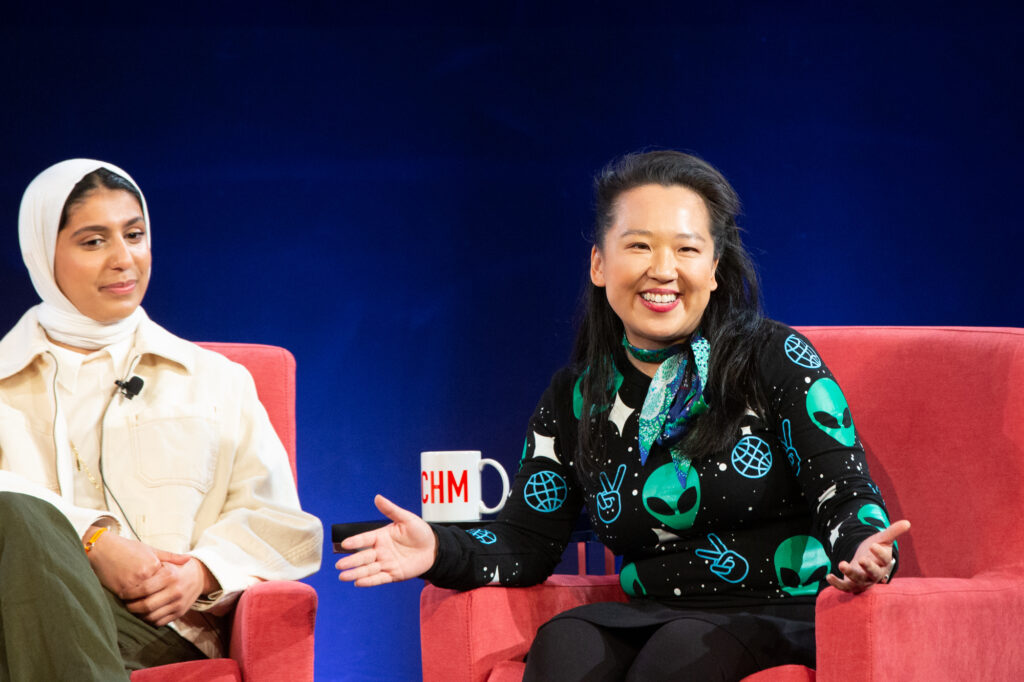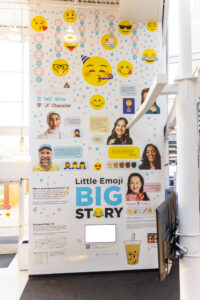Are you part of the 92%? That’s the percentage of people who use emojis worldwide. Beyond just a friendly mode of self-expression, emojis have become a visual language that’s expanding every day to allow people to share culture, creativity, and identity.
On March 8, 2023, CHM Live explored how emojis can be more inclusive and who makes decisions about how new emojis are added. Journalist, film producer, and emoji activist Jennifer 8. Lee, artist Yiying Lu, and one of Time magazine’s “most influential teens,” Rayouf Alhumedhi, joined moderator and professor Sara Dean for a lively discussion.

Rayouf Alhumedhi (left) and Yiying Lu (right) on stage at CHM Live.
🥟 🧕 🥡 🥢 🥠
Before Unicode standardized how languages (and emojis) work on smart devices, things were "a mess," according to a clip from Jennifer 8. Lee’s documentary film, The Emoji Story. Emojis looked different on different phones. You might send a friend a heart emoji and they saw something entirely different. But, unlike established languages that evolve organically, Unicode is continuously evaluating newly invented emojis to determine whether to include them in this new visual language. Their emoji subcommittee gets hundreds of proposals but only incorporates about 60 new emojis every year.
Yiying Lu started designing emojis when she was invited to a party and couldn’t text back her favorite food—a dumpling. She went on to design emojis for not only a dumpling but also a fortune cookie, takeout box, and boba tea. Designing a chopstick emoji made her realize the importance of multigenerational and multicultural points of view.
Yiying Lu gives context for her emoji chopstick design.
As a Gen Z teenager, Rayouf Alhumedhi designed an emoji featuring the hijab, the headscarf worn by millions of Muslim women and girls like her. Both Yiying and Rayouf were surprised they needed to submit hard data to the subcommittee to prove the extensive popularity of the hijab and boba tea—something they felt was obvious in their cultures.

The woman in a headscarf emoji designed by Rayouf Alhumedhi.
When Jenny 8. Lee discovered that decisions about what new emojis to include were made by a group of mostly older, white, male engineers in a conference room in Silicon Valley, she was inspired to start Emojination, a grassroots organization to propose more inclusive emojis. They've been responsible for over a hundred new emojis, and Jenny has since served as vice-chair on the subcommittee.

Skin tone options for emojis created by Katrina Parrott.
After Katrina Parrott’s daughter couldn’t find an emoji that looked like her, Katrina developed five different skin tones for emojis. In a clip from The Emoji Story, she notes that it doesn’t feel good to have to send an emoji that doesn’t look like you, particularly for a young person. Jenny 8. Lee discussed the implications of emojis as a new visual language.
Jenny 8. Lee explores how emojis form a visual language.
In attempting to help more people see themselves in emojis, a lot of work is being done with gender. According to Jenny, as recently as 2015, there were many professions and roles for male emojis and only four for female: dancer, princess, Playboy bunny, and bride. Now, there are gender-neutral versions of emojis for all kinds of roles—even a gender-neutral alternative for Santa Claus.
What can emojis add to the way we communicate? Vendors of boba tea and dumplings have told Yiying that her food emojis have helped their small businesses by giving visibility to their products. Rayouf notes the practicality of emojis as well as how they enable self-expression.
Rayouf Alhumedhi describes how emojis can express identity.
When Jenny talked to a linguist, she realized that images like emojis have trouble expressing words like “you” or “I.” She was thrilled when someone submitted a proposal of a pointing finger to represent “you” to the emoji subcommittee. Jenny believes that’s the power of an open process that allows anyone to participate. She recalled how she was profoundly affected by working to make it possible to represent an interracial couple with emojis. They could now use this ever-evolving new language to express their love.
Emoji for Everyone | CHM Live, March 8, 2023

CHM's new wall display features emojis designed by Yiying Lu! Learn more.
Blogs like these would not be possible without the generous support of people like you who care deeply about decoding technology. Please consider making a donation.